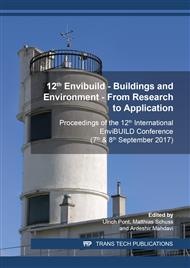[1]
Normey-Rico, J. E., and E. F. Camacho. Control of dead-time processes. 1st ed. London: Springer, c2007. Print.
Google Scholar
[2]
Tahersima, Fatemeh, Jakob Stoustrup, and Henrik Rasmussen. An analytical solution for stability-performance dilemma of hydronic radiators,. Energy and Buildings 64 (2013): 439-446.
DOI: 10.1016/j.enbuild.2013.05.023
Google Scholar
[3]
Afram, Abdul, and Farrokh Janabi-Sharifi. Review of modeling methods for HVAC systems,. Applied Thermal Engineering 67.1–2 (2014): 507-519.
DOI: 10.1016/j.applthermaleng.2014.03.055
Google Scholar
[4]
Xu, B., L. Fu, and H. Di. Dynamic simulation of space heating systems with radiators controlled by TRVs in buildings,. Energy and Buildings 40.9 (2008): 1755-1764.
DOI: 10.1016/j.enbuild.2008.03.004
Google Scholar
[5]
Tahersima, F. et al. Thermal analysis of an HVAC system with TRV controlled hydronic radiator,. 2010 IEEE International Conference on Automation Science and Engineering, CASE 2010. Department of Electronic Systems, Aalborg University, Denmark: N.p., 2010. 756-761.
DOI: 10.1109/coase.2010.5584535
Google Scholar
[6]
Shipworth, M. et al. Central heating thermostat settings and timing: Building demographics: Building demographics,. Building Research and Information 38.1 (2010): 50-69.
DOI: 10.1080/09613210903263007
Google Scholar
[7]
Tunzi, Michele et al. Method to investigate and plan the application of low temperature district heating to existing hydraulic radiator systems in existing buildings,. Energy 113 (2016): 413-421.
DOI: 10.1016/j.energy.2016.07.033
Google Scholar
[8]
Šikula, Ondřej, Pavel Charvát, and Dalibor Rozehnal. Vliv náhřevu a chladnutí otopných těles na energetickou náročnost budov,. Vykurovanie 2017: 25. medzinárodná vedecko-odborná konferencia. Bratislava: SSTP Bratislava, 2017. 399-403. Print.
Google Scholar
[9]
Boháč, J., and J. Bašta. Temperature fields dynamic of panel radiators,. Vytapeni, Vetrani, Instalace 25.1 (2016): 2-5.
Google Scholar
[10]
Jiří, Bartůšek. Dynamika topných ploch a těles včetně regulačních ventilů,. Diplomová práce. N.p., 2014. 18 Jan. (2017).
Google Scholar
[11]
Jančík, Luděk, and Jiří Bašta. Setrvačnost náběhu a chladnutí otopných těles,. TZB- info 2008.1 (2008): 1-3. 18 Jan. (2017).
Google Scholar
[12]
Makal, Tomáš. Hydraulika deskových otopných těles,. Diplomová práce. N.p., 2015. 18 Jan. (2017).
Google Scholar
[13]
Bašta, Jiří, and Jindřich Boháč. Dynamické chování otopných těles s ohledem na regulační zásah,. TZB- info 2013.2013 (2013): 1-3. 18 Jan. (2017).
Google Scholar
[14]
Jančík, Luděk, and Jiří Bašta. Posouzení dynamického chování otopných těles termografickou metodou,. Simulace budov a technika prostředí 2008: Sborník 5. konference IBPSA-CZ. Praha: Česká technika - nakladatelství ČVUT, 2008. 45-48. Print.
Google Scholar
[15]
Petráš, Dušan. Nízkoteplotné vykurovanie a obnovitel'né zdroje energie. Bratislava: Jaga group, 2001. Print.
Google Scholar
[16]
Boss, B. Thermostatic radiator valves for multiunit residential buildings,. HPAC Heating, Piping, AirConditioning Engineering 87.7 (2015): 16-20.
Google Scholar
[17]
Monetti, V., E. Fabrizio, and M. Filippi. Impact of low investment strategies for space heating control: Application of thermostatic radiators valves to an old residential building: Application of thermostatic radiators valves to an old residential building,. Energy and Buildings 95 (2015): 202-210.
DOI: 10.1016/j.enbuild.2015.01.001
Google Scholar
[18]
Danfoss Ltd, RA2000 Commercial TRVs, Part No: 410v06 05/16.
Google Scholar
[19]
Danfoss HS, Data sheet, Radiator thermostats type RA2000, valve bodies type RA-FN (series D) and RA-G. 12/2010 | VDSXG202.
Google Scholar
[20]
Honeywell Environmental Controls. (2007).
Google Scholar
[21]
EN 215/A1 Thermostatic radiator valves: Requirements and test methods. 2nd ed. Brussels: CEN, 2006. Print.
Google Scholar
[22]
Radiator TOMTON R1. Technical specifications. Available from:http://www.tomton-radiators.com/en.
Google Scholar


